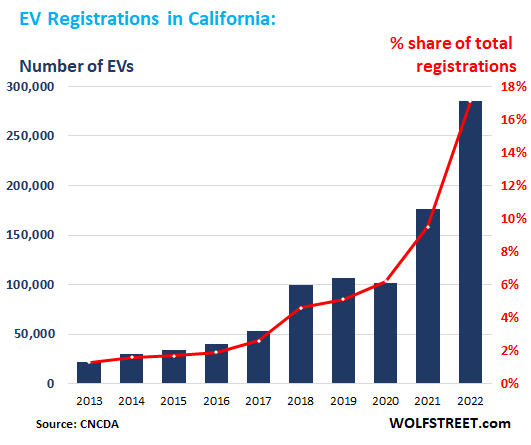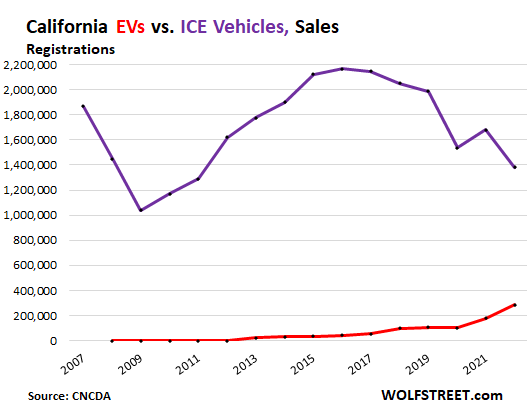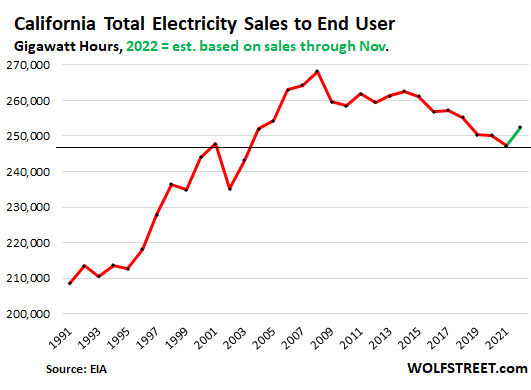Camry was dethroned as perennial #1 by Tesla Model Y & Model 3. And finally a little growth for electric utilities.
By Wolf Richter for WOLF STREET.
Sales of battery-electric vehicles (EVs) in California spiked by 62% in 2022, to 285,199 vehicles, according to registration data released by the California New Car Dealer Association (CNCDA). And the market share of EVs nearly doubled to 17% of total new vehicle sales:

Overall vehicle sales in California, ICE vehicles and EVs combined, fell by 10% to 1.67 million vehicles in 2022. In the US overall, new vehicle sales fell by 8%.
Sales of vehicles with internal combustion engines (ICE) plunged by 18% in California to 1.38 million vehicles, the lowest since 2011, when the auto industry was crawling out of the Great Recession that had sent GM, Chrysler, and a slew of component makers into bankruptcy.
This chart shows sales of EVs (red) and sales of ICE vehicles only (purple). And note that the new federal EV incentives didn’t apply in 2022; and that Tesla and GM had used up their allotment of previous federal incentives years ago:

In an overall down market – this is playing out across the US though to a lesser extent – EV sales are booming, and ICE vehicle sales are sagging, amid lots of new EV models by legacy automakers and startups chasing after Tesla, and the price cutting has started.
And in the enormously important (in the US) segment of pickup trucks, two automakers – Ford and Rivian – beat Tesla to market with electric pickup trucks.
Perennial bestseller Camry dethroned by EVs in 2022.
Tesla’s Model Y was the #1 bestselling model in California in 2022 (with 87,257 registrations) and the Model 3 was the #2 bestselling model (with 78,934 registrations), both beating by a wide margin the Toyota RAV4 (59,794 registrations) and the Toyota Camry (55,967 registrations).
Toyota and Honda used to rule California. Going back to the 1990s, the Camry and the Civic fought over the top two slots.
In 2021, the Camry was still the #1 bestseller (61,599), chased by the Model Y (60,394). The Honda Civic had dropped to #3 (59,818), just ahead of #4, the RAV4 (59,157). The Model 3 was #5 (53,572).
So for the California auto market, it was quite a show in 2022: The year when Toyota and Honda models were dethroned, and not by Ford or by GM or whatever, but by EVs, and by a wide margin.
It helps that Teslas are manufactured in California. No other automaker assembles vehicles in the state. In 2010, Toyota and GM abandoned their joint venture at the NUMMI plant in Fremont, and eventually Tesla took over the plant.
Teslas are now also manufactured in Texas, providing additional supply for the US market. This additional supply was why in California Model Y sales jumped by 44% and Model 3 sales by 47% year-over-year. But sales of the Camry dropped by 9%.
The auto industry was still dogged by supply problem in 2022, when it got further sideswiped by a shift in demand from trucks and big SUVs to fuel efficient vehicles and EVs, as gas prices shot higher in early 2022.
There is now plenty of supply of trucks and SUVs, but fuel-efficient vehicles were in short supply. The US brands have largely abandoned fuel efficient sedans, handing that market to the import brands and EVs. Many of these models have waiting lists. This is the case in much of the US, including in California.
EVs: Electric Utilities see exit from 13 years of declining demand.
The large-scale effort on efficiency by households, office buildings, and industrial plants, and relatively little need for air-conditioning in the coastal strip where the vast majority of Californians live, caused electricity sales to decline for 13 years.
Electricity sales to end users had peaked in 2008 at 268,000 Gigawatt hours, and then wobbled lower, according to the annual data provided by the EIA. By 2021, sales were down 8% from the peak, and had fallen below the sales of 2001! This is a terrible situation for an industry that is configured for growth and makes new investments nearly impossible.
The annual data is not yet available for 2022. But monthly data through November indicate that electricity sales in 2022 rose 2.1% from a year earlier. Assuming that December had a similar increase, electricity sales showed the first real bump since 2008. But they’re still only back roughly where they’d first been in 2005.
This marks the first year that we can see the uptick of demand from EVs show up in the chart:

EV owners who have a charger at home charge their vehicles at night when rates are lower (time-of-use pricing). This creates electricity consumption at a time when there is very little other demand. It allows electric utilities to make some money off their otherwise idle capacity. This demand in the middle of the night doesn’t require additional investment by the utility. This load in the middle of the night may turn out to be one of the best things that ever happened to utilities.
Electric utilities are like any other company: they need growth. But in California, they have been stuck with declining demand. This makes investment in new infrastructure nearly impossible because there isn’t enough demand for it. Utilities are designed like landlords: They borrow large amounts cheaply to fund big investments, and then earn a steady stream of revenues for decades from these investments, which justifies issuing bonds and makes investors happy. But the whole model fell apart when demand began to sag year after year.
Demand from EVs is now showing the first signs of reversing the decline. It’s still just a small uptick, and it’s only the first one, but it’s a great moment for the utility industry.
Just like EVs have unleashed hundreds of billions of dollars of investment by automakers in the US, and have created all kinds of new well-paid jobs, EVs will give the electric utility industry in California a path to growth.
Enjoy reading WOLF STREET and want to support it? You can donate. I appreciate it immensely. Click on the mug to find out how:
![]()


Dear readers,
I disabled comments on this article due to BS overload on my prior EV article. That’s too bad, but I’d never encountered so much BS in such a short time. It was just stunning.
Article after article, year after year, when “EV” was in the headline, EV deniers converged on the article and bombarded it with the same copy-and-paste BS, why EVs can never work and will never work, that they’re too heavy, to expensive, too toxic, to inefficient, that their range is only 20 miles when it gets cold, that they’re burning coal, that you can’t drive across the country with them every day, that the grid can never… and yada-yada-yada.
EV articles bring out the worst and silliest comments in the history of mankind. As EVs have become more and more commonplace, EV deniers have become more and more desperate in their BS. But I’ve had it. I’m done.
EVs are the biggest most exciting development in the US auto industry and US manufacturing in decades. They’re huge for jobs and technology. They’re huge money-making opportunities for electric utilities and power generators. Property developers are starting to incorporate charging infrastructure. EVs are huge for the oil industry and for gasoline retailers — but not in a good way. They’re a huge economic development all around.
Comments on this article are closed due to BS overload on my prior EV article.